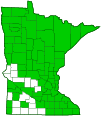Northern Crescent
(Phyciodes cocyta)
Conservation • Description • Habitat • Ecology • Distribution • Taxonomy
|
|
|||||||||||||
Description |
Northern crescent is a medium sized brushfoot butterfly. It has a wingspan of 1″ to 1⅜″. It is very common in Minnesota. The upperside of the both wings is orange with a broad black border and a black-and-white fringe. There is a small to large patch in the basal area that is is mostly black with many fine, pale specks. The female is larger, darker, and more extensively marked than the male. The upperside of the forewing has four irregular black patches: a subapical patch that merges with the black border; a submarginal patch near the inner margin that merges with the black border; a median patch on the leading (costal) margin; and a median patch on the inner margin. On most individuals, a black jagged line separates the median area from the postmedian area and widens into an irregular black patch near the costal margin. On the female, the median area is yellowish-orange. There are jagged lines in the discal area that form one or two outer and a row of inner orange spots with black borders. The upperside of the hindwing has a submarginal row if pale, crescent-shaped spots within the black border. There is a broad, open, median and postmedian area with row of small black spots and jagged, interrupted, postmedian line. Jagged lines in the discal area create three rows of irregular orange spots with black borders. The underside of the forewing is orange with pale orange costal and apical areas; thin, jagged, dark orange lines; and two ill-defined black patches near the costal margin. The underside of the hindwing is pale orange with thin, jagged, dark orange lines; an ill-defined, dark orange patch near the costal margin, and a dark brown patch near the trailing edge. On females, the pale areas are orangish-yellow and the lines are more highly contrasted. The antennae are black and white striped. The antenna clubs are black and white striped with an orange tip. The legs are orangish-yellow. The caterpillar is up to ¾″ long and dark brown with numerous tiny white spots. The spots are the expanded base of the hairs (seta). On the thorax and each abdominal segment there is a short, branched spine (scolus) in the middorsal, subdorsal, supraspiracular, spiracular, and subspiracular regions. The base of the scolus is rounded, wart-like, reddish-orange, and shiny. There is a broken white line in the subdorsal and subspiracular areas that extends onto the head. |
Size |
Wingspan: 1″ to 1⅜″ |
Similar Species |
Pearl crescent (Phyciodes tharos) has a smaller speckled black area on the wing uppersides near the body. The hindwing postmedian line is continuous and unbroken. There is a pearly white spot in the brown patch in the underside of the hindwing. The flight season begins in May. |
Habitat |
Meadows, fields, streamsides, roadsides, and other moist open spaces. |
Ecology |
Season |
Two broods: June to early July, and August to mid-September |
Behavior |
Young caterpillars feed in groups but do not create nests. |
Life Cycle |
The male patrols near host plants in search of a receptive female. After mating, the female lays green eggs on the underside of aster leaves in a raft of usually about 40 but as few as 20 to as many as 300. The second brood overwinters as a third-stage caterpillar. |
Larva Hosts |
White panicle aster (Symphyotrichum lanceolatum), smooth blue aster (Symphyotrichum laeve), and other asters (Symphyotrichum spp.). |
Adult Food |
Flower nectar of spreading dogbane (Apocynum androsaemifolium), white clover (Trifolium repens), fleabane (Erigeron spp.), thistle (Cirsium spp.), and aster (Symphyotrichum spp.). |
Distribution |
||
|
Sources |
|
| 7/12/2024 | ||
Occurrence |
||
Very common |
||
Taxonomy |
|
Order |
|
Superfamily |
Papilionoidea (Butterflies) |
Family |
|
Subfamily |
Nymphalinae (Checkerspots, Anglewings, Peacocks, and Allies) |
Tribe |
Melitaeini (Checkerspots) |
Subtribe |
Phyciodina |
Genus |
Phyciodes (crescents) |
Species or Subspecies? The Phyciodes tharos group contains 4 species that are closely related genetically: P. tharos, P. cocyta, P. batesii, and P. pulchella. A molecular phylogenetics, phylogenomics, and phylogeography study of crescent butterflies in the Phyciodes tharos group was published on March 28, 2024 (Wingert et al., 2024). The authors concluded that “Phylogenetic and cluster-based analyses confirm that there are indeed 4 species based on the maintenance of genomic integrity in the presence of occasional hybridization and low levels of gene flow.” Global Biodiversity Information Facility (GBIF) classifies P. cocyta as a synonym of P. tharos. They appear to be unique in doing so. They list the subspecies of P. cocyta under P. tharos, yet they keep the former subspecies’ trinomial names. For example, under Phyciodes tharos, they list the subspecies Phyciodes cocyta subsp. cocyta, Phyciodes cocyta subsp. diminutor, and Phyciodes cocyta subsp. selenis. They appear to be unique in doing this as well. Minnesota Biodiversity Atlas lists only Phyciodes selenis/tharos. |
|
Subordinate Taxa |
|
diminutive Northern Crescent (Phyciodes cocyta diminutor) mimic crescent (Phyciodes cocyta incognitus) Northern Crescent (Phyciodes cocyta cocyta) Northern Crescent (Phyciodes cocyta pascoensis) Northern Crescent (Phyciodes cocyta selenis) Steptoe Valley checkerspot (Phyciodes cocyta arenacolor) |
|
Synonyms |
|
Melitaea marcia Melitaea selenis Papilio cocyta Papilio morpheus Phyciodes apache Phyciodes arctica Phyciodes arenacolor Phyciodes dyari Phyciodes herse Phyciodes macdunnoughi Phyciodes mcdunnoughi Phyciodes nigrescens Phyciodes pascoensis Phyciodes reaghi |
|
Common Names |
|
Northern Crescent |
|
Glossary
Costal margin
The leading edge of the forewing of insects.
Pupa
The life stage of some insects undergoing transformation. In caterpillars, the chrysalis.
Scolus
A spiny, branched projection from a larval body wall, the branches terminating with a single stiff, hair-like or bristle-like tip.
Seta
A usually rigid bristle- or hair-like structure on Butterflies and Moths used to sense touch. Plural: setae.
Spiracle
A small opening on the surface of an insect or arachnid through which it breathes.
Visitor Photos |
||
Share your photo of this insect. |
||
This button not working for you? |
||
Mike Poeppe |
||
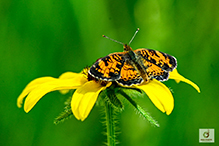 |
|
|
Lynn Rubey |
||
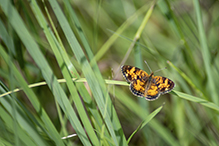 |
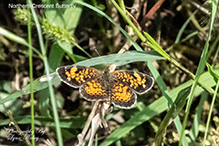 |
|
The female Northern Crescent Butterfly settled on this blade of grass for a short time. Females are darker than males and only recently been recognized as a seperate species. |
Northern Crescent Butterfly at the Big Stone Wildlife Refuge |
|
Luciearl |
||
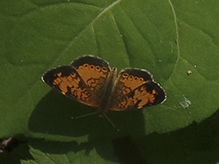 |
||
Alfredo Colon |
||
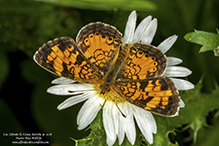 |
||
Tom Baker |
||
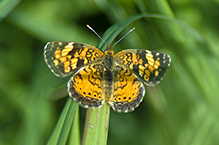 |
||
MinnesotaSeasons.com Photos |
||
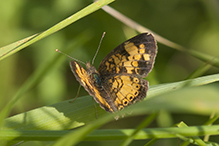 |
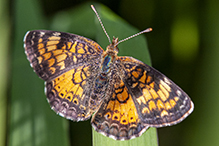 |
|
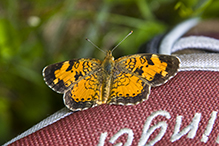 |
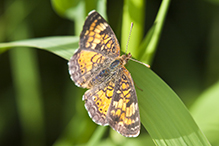 |
|
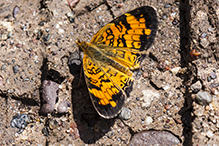 |
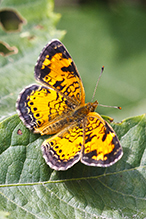 |
|
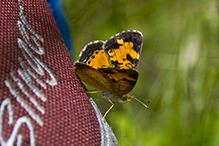 |
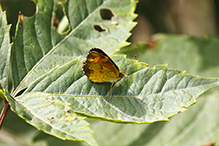 |

Slideshows |
Northern Crescent |

|
About
Copyright DianesDigitals Phyciodes selenis |
Northern Crescent (Phyciodes cocyta) |
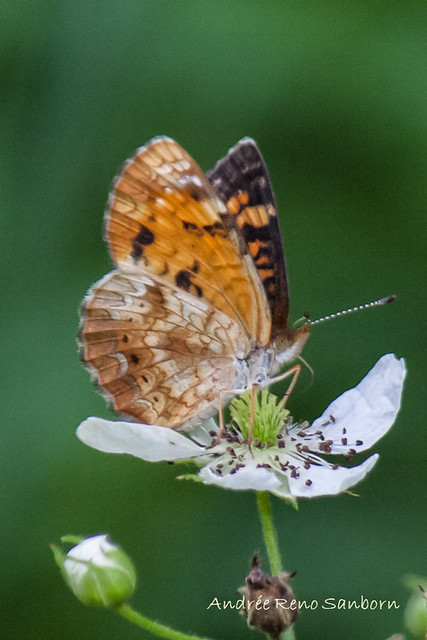
|
Phyciodes selenis (Northern Crescent) |
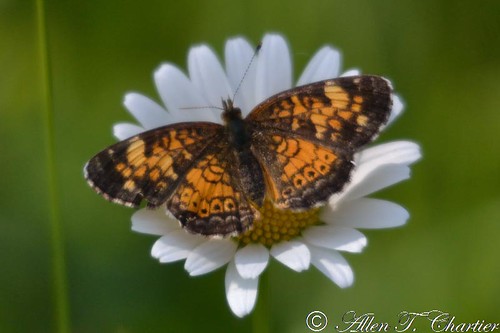
|

Visitor Videos |
||
Share your video of this insect. |
||
This button not working for you? |
||
|
Other Videos |
||
Northern Crescent (Nympahlidae: Phyciodes cocyta) on Ground |
About
Uploaded on Jun 17, 2010 Photographed at the Rydell NWR, Minnesota (16 June 2010). |
Northern Crescent (Nymphalidae: Phyciodes cocyta) on Gravel |
About
Uploaded on Jul 8, 2010 Photographed at the Glacial Ridge NWR, Minnesota (07 July 2010). |
Northern Crescent Butterfly |
About
Uploaded on Jul 30, 2011 Gorgeous Northern Crescent Butterfly flapping its wings. |

Visitor Sightings |
||
Report a sighting of this insect. |
||
This button not working for you? |
||
| Mike Poeppe 7/9/2024 |
Location: Houston County, MN |
 |
| Luciearl 6/10/2019 |
Location: Cass County |
 |
| Lynn Rubey 9/7/2018 |
Location: Big Stone Wildlife Refuge Northern Crescent Butterfly |
 |
| Alfredo Colon 8/31/2018 |
Location: Woodbury, Minnesota |
 |
MinnesotaSeasons.com Sightings |
||

Created: Last Updated: © MinnesotaSeasons.com. All rights reserved. |
